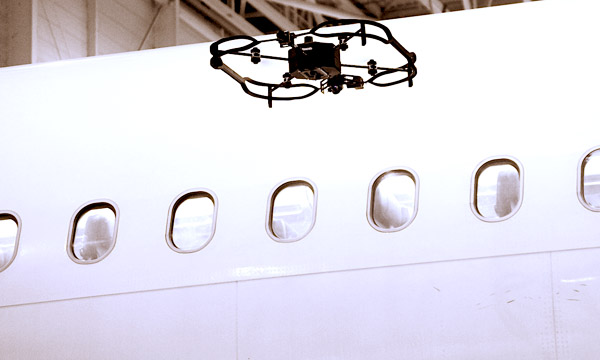Donecle sets its drone to work for maintenance with AFI KLM E&M |
| Léo Barnier |
|
|
20 JUL 2017 | 1177 words
|
 |
© Donecle |
|
|
|
While structure inspection quickly stood out as one of the obvious applications for civilian drones, the idea is taking a little longer to break through for aircraft inspection. Nevertheless, it is starting to make its mark thanks to demonstrations from time to time and industrial experiments which are a little more advanced. We could soon be seeing it regularly in industrial environments, with Airbus which has been working in partnership with Intel since 2015 for example, but it might soon also be the case in operational environments. In any event, this is the objective of Donecle, a Toulouse-based start-up which is developing its drone and its own inspection resources. And this is stirring up interest: it is currently carrying out a major pilot programme with Air France Industries - KLM Engineering & Maintenance (AFI KLM E&M).
"Visual inspection is a hugely time-consuming process", begins Yann Bruner, Chief Executive of Donecle. "It eats up 20 million hours of work per year. Between the cost of the inspection and the loss of income due to the aircraft being grounded, one hour's unscheduled inspection can cost $10 000. And it takes an average of eight hours to inspect an aircraft. This is the equivalent of two Paris-Toulouse trips". He supports this by specifying that 90 to 95% of these inspections do not lead to any maintenance actions.
To save time, Donecle has got to work on developing a quicker solution. The young company has fully developed an 80x80cm "flying, independent and automated" platform. Yann Bruner estimates that they can cut inspection time by a factor of 20, so between 20 and 30 minutes for a medium-haul plane with a single drone.
Lidar rather than GPS
As nearly 80% of inspections take place inside a hangar, Donecle has chosen to ignore GPS in favour of remote detection by laser (lidar) to perceive its environment and be guided. To do so, it integrates the digital model of the plane to be inspected into the navigation system combined with the lidar. Placed near the aircraft, the drone will start by scanning its structure to recognise it. This will enable it to position itself in space in relation to the plane and to move around with no risk of colliding with it. "Our solution works both indoors and outdoors", Yann Bruner is happy to add. Lidar also enables any intrusion into the working area to be noted and for the mission to be interrupted temporarily - or permanently if the person or object remains within the area.
At the same time, the start-up has designed its sensor. For now, it is supported by a 12 megapixel HD camera. The camera is placed at the front of the drone and may be turned 180° vertically. It can inspect both the outside and inside of the aircraft. Its combination with the navigation system enables geolocated photos at the scale of the plane to be obtained. The images may then be superimposed on the digital model to find out exactly which elements of the structure are affected by a fault, something which is not necessarily possible with the naked eye.
Donecle's solution should be able to be implemented by a single operator, with their drone and their ground station, in 5 minutes. The operator places their drone near the aircraft and selects the type of mission they want. The drone then positions itself, goes to its mission start point and starts its inspection automatically. The operator doesn't need to control it, but has real-time monitoring from their ground station. They can decide on any maintenance actions to be carried out from the images sent by the drone. This is the type of work currently being carried out by AFI KLM E&M to inspect its regulatory markings.
First step
Yann Bruner thinks that this is just a first step and that Donecle is only beginning to explore its solution's capabilities: "At the moment, we are still just providing inspection assistance. We want to go further". The company is working on a "smart camera which is able to detect, locate and characterise a fault in real-time". In time, the drone and its sensor will be able to detect the fault, to define its size and nature (paintwork missing, rivet missing, corrosion, deformation, etc.) and to indicate precisely to the operator its location on the aircraft thanks to lidar. Yann Brunner can even see a day when the system is able to send an automated damage report quickly or recommend a maintenance action.
To achieve this, Donecle must implement an artificial intelligence layer. The start-up has begun to develop algorithms with this in mind, but it still needs to "train" them to recognise and categorise faults. To do so, it needs to have a large enough database to start - Donecle will retrieve its data via a cloud storage solution - then continue to enhance it with new data from the drones' operations. Yann Bruner wants to be able to combine the data over time, with traceability, but also between the different aircraft. The system could then be able to note any recurring faults and enable the customer company to work on the source and predictability of its faults.
Other improvements are being considered. To increase speed, Donecle is studying the possibility of combining several drones to inspect a single plane, especially long-haul planes. Other sensors, such as infra-red sensors, could also be integrated. The aim is to obtain the necessary accreditation to operate in international airport environments. Yann Bruner dreams if being able to carry out "on the fly" inspections on planes and so prevent any unnecessary grounding.
Two-year objectives
While Donecle is ambitious, the company still wants to take its time. Yann Bruner wants to spend another two years developing the full solution before making it operational" "We're already getting results, but they're not enough yet for the aviation sector". Nevertheless, given that it takes around 18 months to be accepted in the aviation industry, he is already contacting airlines. He hopes to be able to build up a group of around twenty customers by 2019, mainly from airline branches or subsidiaries, and so help his solution mature and develop its capacities over a wider range than at the moment. The solution has already been demonstrated in several countries and advanced contact has been made in North America and the Middle East. Donecle hopes to start signing up customers within the year.
The start-up has positioned itself on a leasing model for its solution, with training for operators at customer airlines. An all-inclusive service, with an operator sent by Donecle to the customer's premises, would not meet the speed requirements. Leasing contracts would be determined by the level of use and the type of mission carried out. Here again, the objective is to be profitable within two years. For now, Donecle is still looking for financing; a first EUR1M fund raising operation was held in 2016 and a second for EUR5M should come to fruition at the end of 2017 / beginning of 2018.
|
|
 |
Léo Barnier
Specialized journalist
Industry & Technology, Equipments, MRO
|
|
| |
They made this section possible |
|
|
|
|
|
|
|
|
|
|
|
|
|
|
|
|
Top stories |
|
|
|
|
|
Top stories
|